
Tri-Clamp Fitting
Tri-clamps or Triclover fittings are a class of sanitary flanges, clamps, gaskets and other fittings that can be of great use for the still builder. They are used in column to boiler connections, breaks in the column to allow for modular setups, detachable takeoff / lyne arms, sight glasses, fill and drain ports on the boiler, food processing industry that uses a non-permanent sanitary food-grade piping interconnect method, and many other uses.The interconnect consists of:A lip flange on the ends of pipes with a grooved indentation on the flange.A polymer sealing gasket placed between sections of pipe, squeezed between the flanges. This ring has a raised groove on both sides mating with the indentations of the two pipes on either side.An enclosing clamp with C-shape clamping sections that cover the outer circumference of the flanges, applying pressure to squeeze the two pipe sections together onto the sealing ring. The clamp also provides structural strength and rigidity to the pipe sections.The combined lip flange and gasket do not impede the flow of fluids through the piping.The clamping system may be permanent, using a hose clamp style screw and band, or it may be easily removable using a fold-over hinged clamp assembly.
...more
Tee Fittings
A tee is the most common pipe fitting. It is available with all female thread sockets, all solvent weld sockets, or with opposed solvent weld sockets and a side outlet with female threads. It is used to either combine or split a fluid flow. It is a type of pipe fitting which is T-shaped having two outlets, at 90° to the connection to the main line. It is a short piece of pipe with a lateral outlet. A tee is used for connecting pipes of different diameters or for changing the direction of pipe runs. Equal Unequal When the size of the branch is same as header pipes, equal tee is used and when the branch size is less than that of header size, reduced tee will be used. Most common are tees with the same inlet and outlet sizes.
Country of Origin : India
Material : Metal
Thickness : 60-80mm
Feature : Shocked Resistance
Technics : High Density Polyethylene
...more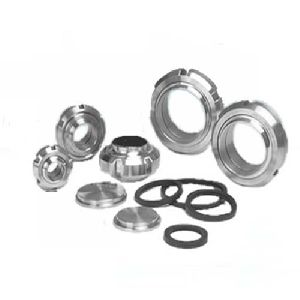
sms fittings
SMS fittings are named from Swedish Dairy Standard ( Svensk Meieri Standard )Swedish standard union incorporates a round slotted nut and features a crevice free flat section lipped seal. The union is suitable for use on permanently fitted sections of pipework and is generally unforgiving on misaligned joints. The fitting does have the advantage over other designs in that it facilitates the removal of sections of pipework without the need to disturb adjacent sections. The standard material for the seal is EPDM.There are a multitude of variants in pipe-clips and clamps and couplings and unions that is commonly used all over Europe. Like the DIN 11851 union, SMS fittings are used extensively in the UK and throughout Europe. This is a hygienic fitting with a crevice free design and has the added advantage that it is totally removable in position. This feature enhances the union's suitability for use in frequently dismantled systems.The fittings can be welded & fabricated onto a range of products including special bends, tees, valves & manifolds.
...more
shell moulding
ell molding, also known as shell-mold casting, is an expendable mold casting process that uses a resin covered sand to form the mold.Shell moulding is similar to sand moulding except that a mixture of sand and 3-6% resin holds the grains together. Shell moulding also uses sand with a much smaller grain than green-sand. Set-up and production of shell mould patterns takes weeks, after which an output of 5-50 pieces/hr-mould is attainable. Aluminium and magnesium products average about 13.5 kg as a normal limit, but it is possible to cast items in the 45-90 kg range. Shell mould walling varies from 3-10 mm thick, depending on the forming time of the resin.Shell moulding is used for small parts that require high precision. Some examples include gear housings, cylinder heads and connecting rods.It is also used to make high-precision moulding cores. Compared to sand casting this process makes complex parts be cast with better dimensional accuracy, a higher productivity rate, and lower labor requirements. less labor. There are a dozen different stages in shell mould processing that include: 1. Initially preparing a metal-matched plate 2. Mixing resin and sand 3. Heating pattern, usually to between 505-550K 4. Inverting the pattern 5. Curing shell and baking it 6. Removing investment 7. Inserting cores 8. Repeating for other half 9. Assembling mould10. Pouring mould11. Removing casting12. Cleaning and trimming.The sand-resin mix can be recycled by burning off the resin at high temperatures.
...more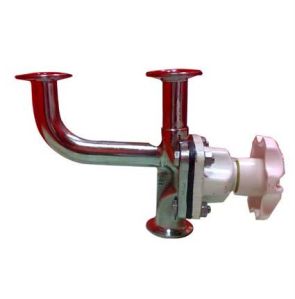
gmp loop valve
The GMP loop valves can be utilized to virtually eliminate dead legs in the design of point of use outlets in a typical WFI distribution loop.The process fluid flows through the valve body.Design Features: As demand warrants, the valve is opened providing an uncontaminated sample untainted by bacteria growth or contaminated which may accumulate in outlets greater than 6D. The outlet can also be utilised as a steam condensate drain or as a divert port.The valve has been modified to accept a third port of the same diameter or smaller, positioned adjacent to the weir at the bottom of the valve. Applications: Typically the GMP valve is oriented in the vertical position. For horizontal process applications, the sterile access valve is recommended. Sizes:The GMP configuration is available in sizes ¼"-4"(DN 8-100) and can be supplied with buttweld or ferrule end connections.
...more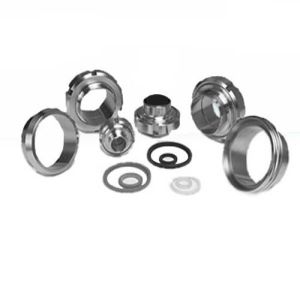
DIN Fittings
DIN fittings are named from Deutsches Institut für Normung(DIN)The DIN union is widely used throughout Europe and incorporates a round slotted nut and a flush fitting lipped seal, as standard. The union is manufactured to suit Imperial tube sizes from 1" to 4" and also to suit DIN metric tube from 10mm to 150mm. Two seals designs are offered for the fitting, namely the flush fitting and crevice free lipped seal and also the cheaper D section seal. The standard seal material is Nitrile/Perbunan and is generally blue or grey in colour. The male features an inverted cone face that carries the seal, while the liner is similarly conical with a flat face to effect a clean hygienic joint.The seals are available in two forms, the flanged or lipped design which provides a flush fitting and crevice free joint, or the more commonly used unlipped seal.The fittings can be welded & fabricated onto a range of products including special bends, tees, valves & manifolds.
...more
Diaphragm Valves
manufactured from SS 316/SS316L investment castings and duly electro polished to 240 # internal surface. End connections can be tri-clamp, flanged or butt wed.Design Features: The diaphragm isolates the working parts of the valve from the process fluid. The smooth contoured body, electropolished interior surface prevents accumulation of process fluids and contaminants. The process contact surfaces (body and diaphragm) are minimum enhancing cleaning and sterilisation. The flexible diaphragm in contact with the metal weir ensures positive closure.Diaphragm can be silicon, Teflon or EPDM. Applications: Process control in batch operation, ideally suited for vacuum application, bubble shut closed position, sanitary internals make it an ideally suited cGMP application. Sizes: From ¼" to 3" in tubing or NB schedule sizes.
...more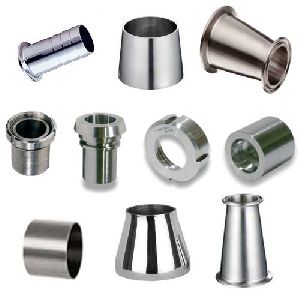
Pipes Coupler
Couplers A coupling connects two pipes to each other. If the size of the pipe is not the same , the fitting may be called a reducing coupling or reducer, or an adapter. By convention, the term "expander" is not generally used for a coupler that increases pipe size; instead the term "reducer" is used. Reducers A reducer allows for a change in pipe size to meet hydraulic flow requirements of the system, or to adapt to existing piping of a different size. Reducers are usually concentric but eccentric reducers are used when required to maintain the same top- or bottom-of-pipe level.
...more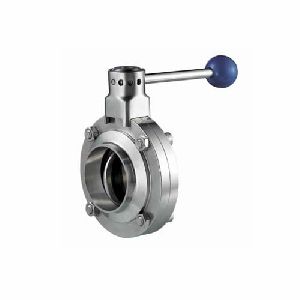
Butterfly Valve
Butterfly valves can be welded,screwed,clamped or flange-fitted into the stainless steel lines and can be actuated manually or automatically as needed.Wide choice of end fittings in male/butt-weld combinations to keep installation costs to a minimum while offering maximum flexibility for maintenance.Butterfly Valves offer great durability and ease of use for a wide range of services. Easy to install and maintain, butterfly valves close under pressure to form a leak-tight seal. End Connections: IDF,SMS,DIN,TC Clamp,butt-weld;(special design with mating flanges that butt-weld to the tube). Material: Machined from SS 304,SS 304L,SS 316L bar stock,fully polished as standard.The standard handle or air actuator is also made from stainless steel.Other actuators available to special order. Sizes:To suit tube outside diameters of 1",1½",2",2½"and 4".
...more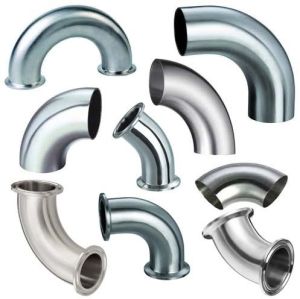
Pipe Bends ,Pipe Elbows
A BEND is the generic term for what is called in piping as an "offset" - a change in direction of the piping. A bend is usually meant to mean nothing more than that there is a "bend" - a change in direction of the piping.An elbow is a pipe fitting installed between two lengths of pipe or tubing to allow a change of direction, usually a 90° or 45° angle , though 22.5° elbows are also made. The ends may be machined for butt welding, threaded (usually female), or socketed, etc. When the two ends differ in size, the fitting is called a reducing elbow or reducer elbow.Elbows are categorized based on various design features as below: Long Radius (LR) Elbows – radius is 1.5 times the pipe diameter. Short Radius (SR) Elbows – radius is 1.0 times the pipe diameter. 90 Degree Elbow – where change in direction required is 90°. 45 Degree Elbow – where change in direction required is 45°.
...more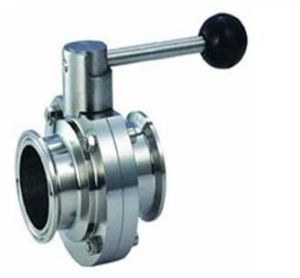
Ball Valve
A range of stainless steel ball valves for sanitary applications in Pharma,Drug,Food, Beverage, Cosmetics, Dairy and Allied Industries.Ball valves are engineered to be a true process piping component to specifically meet the demanding processes found in the pharmaceutical industries which are designed to specifically meet the demanding process where microbial, particle generation and contamination can threaten the outcome of the product. DESIGN FEATURES Manufactured from SS316/SS316L barstock. Two piece and three Piece designs. End connections can be Tri Clover, Burrweld, Flange Thread. Free from uncleanable pockets. Full flow body minimizes line turbulence and pressure drop. Encapsulated teflon seat ensure no contamination.
...more
Butterfly Valves

Stainless Steel Ring Nut
Be first to Rate
Rate ThisOpening Hours